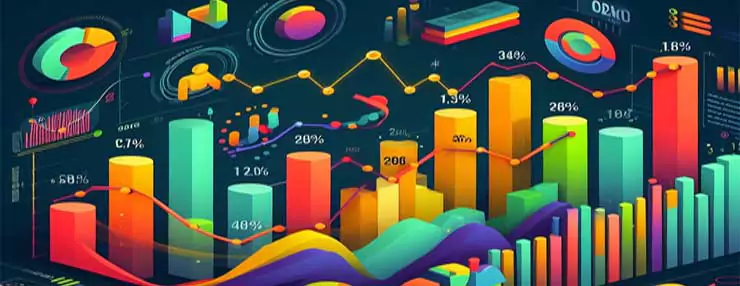Table of Contents
Introduction
Technology has become an integral part of modern life, transforming how we live, work, and interact with the world. In the United States, technology has played a vital aspect in generating employment opportunities and fostering economic expansion. This article explores the multifaceted impact of technology on job creation and economic growth in the US, focusing on key advancements, industries influenced, the role of startups and small businesses, government support, workforce skills, and the future of work. We’ll also delve into the ongoing debate about automation and artificial intelligence, which can boost and displace jobs. By the end of this article, you’ll gain a comprehensive understanding of how technology is driving the future of work in the United States.
What is the Impact of Technology on Job Creation in the US?
The impact of technology on job creation in the United States is substantial. Technology has not only created new job opportunities but has also transformed existing ones. Here are some essential ways in which technology has impacted job creation:
- Automation and Efficiency: Automation technologies have increased efficiency in various industries, leading to the creation of new roles focused on designing, maintaining, and improving automated systems. Implementing robots and artificial intelligence (AI) in manufacturing, for instance, has led to the demand for technicians and engineers to manage and oversee these systems.
- Digital Transformation: The transformation of businesses into digital ones has brought about significant changes related to software development, cybersecurity, data analysis, and digital marketing. As companies move their operations online, the need for skilled professionals to manage and optimize digital infrastructure grows.
- E-commerce: The rise of e-commerce media and online marketplaces has not only created jobs in logistics and delivery but has also led to an increase in customer service, digital marketing, and web development positions.
- Technology Startups: The thriving technology startup ecosystem in the US has given rise to numerous job opportunities, from software developers and data scientists to marketing specialists and project managers. These startups often pioneer innovations, disrupting traditional industries and generating new job prospects.
- Telecommuting and Remote Work: The proliferation of technology has made remote work more accessible, allowing companies to tap into a global talent pool. Remote work has created opportunities for virtual assistants, remote support staff, and digital nomads.
What Are the Key Technological Advancements Driving Economic Growth?
Several key technological advancements have been driving economic growth in the United States. These innovations have not only created jobs but have also propelled the nation’s economy forward. Some of the notable technological advancements include:
- Artificial Intelligence (AI): AI is a game-changer, transforming various industries, from healthcare to finance. AI-powered solutions like chatbots, predictive analytics, and machine learning are optimizing processes and creating demand for AI specialists and data scientists.
- Cloud Computing: Cloud technology has revolutionized data storage, accessibility, and collaboration. It has enabled businesses to scale more efficiently and has driven the growth of cloud service providers, data center technicians, and cloud architects.
- 5G Technology: The deployment of 5G networks is opening up opportunities in sectors like IoT, augmented reality, and autonomous vehicles. As the 5G infrastructure expands, so does the need for professionals in network engineering and cybersecurity.
- Green Technology: The push for sustainable practices and environmental conservation has led to innovations in green technology. Jobs in renewable energy, clean technology, and sustainability consulting have emerged.
- Biotechnology: The biotech industry is making remarkable strides in pharmaceuticals, genetic engineering, and personalized medicine. This has led to job growth in research, clinical trials, and genetic counseling.
- Quantum Computing: Quantum computing has the prospect to revolutionize cryptography, materials science, and optimization problems. As this technology matures, it will create opportunities for quantum physicists, computer scientists, and engineers.

What Industries Are Most Influenced by Technology-Driven Job Creation?
Several industries in the United States have been profoundly influenced by technology-driven job creation. These industries have embraced innovation and reaped the benefits of a tech-centric approach. Notable sectors include:
- Information Technology (IT): The IT industry is a major beneficiary of technology-driven job creation. It includes roles such as software developers, network administrators, cybersecurity experts, and data analysts.
- Healthcare: Healthcare has seen significant growth in telemedicine, digital health, and electronic health records. This has created jobs for healthcare IT specialists, telehealth providers, and health informatics professionals.
- Financial Services: Fintech companies have disrupted the traditional financial industry, resulting in the emergence of jobs in digital banking, peer-to-peer lending, cryptocurrency, and financial analytics.
- E-commerce: The e-commerce sector, led by giants like Amazon, has been a driving force behind job creation. Job opportunities span warehousing and logistics, online marketing, web development, and customer service.
- Manufacturing: Advanced manufacturing technologies, including 3D printing and industrial automation, have revolutionized the manufacturing sector, leading to new roles in robotics, quality control, and process optimization.
- Entertainment and Media: The entertainment industry has been reshaped by streaming services, virtual reality, and augmented reality experiences. Job opportunities have arisen in content creation, digital marketing, and immersive technology development.
What Role Do Startups and Small Businesses Play in This Technological Transformation?
Startups and small businesses play a crucial role in the technological transformation of the United States. They are often at the forefront of innovation, disrupting established industries and creating new job opportunities. Here’s how startups and small businesses contribute to technology-driven job creation:
- Innovation Hubs: Many startups are based in innovation hubs such as Silicon Valley, Boston, Austin, and New York City. These hubs attract top talent and foster creativity and collaboration, leading to technological advancements.
- Niche Specialization: Startups often focus on niche markets or innovative technologies, leading to the creation of specialized job roles. For example, a startup specializing in electric vehicle charging infrastructure may hire experts in electrical engineering and sustainable energy.
- Agility and Adaptability: Startups are agile and can quickly adapt to market changes and emerging technologies. This adaptability creates opportunities for employees to learn and grow in response to evolving industry trends.
- Economic Growth: The success of startups can result in rapid economic growth, benefiting local communities and the broader economy. As these companies expand, they create more job opportunities in various roles.
- Entrepreneurship Ecosystem: The success of startups and small businesses is often intertwined with a robust entrepreneurship ecosystem that provides support through mentorship, funding, and resources. This ecosystem encourages more individuals to start businesses, contributing to job creation.
How Does Technology Contribute to Economic Growth in the US?
Technology is a driving force behind economic growth in the United States. Its contribution can be observed in several ways:
- Increased Productivity: Technology enables businesses to streamline processes, boost efficiency, and produce more with fewer resources. Increased productivity leads to economic growth as companies can meet higher demands and expand their operations.
- Innovation and Competition: Technological advancements foster innovation and competition. Companies that innovate and adopt the latest technologies gain a competitive edge, attracting more customers and expanding their market share.
- Job Creation: As discussed earlier, technology-driven job creation significantly contributes to economic growth. New job opportunities lead to increased consumer spending, further stimulating the economy.
- Investment and Research: Technological advancements require investments in research and development, which spur economic growth. Companies, both large and small, invest in research to stay at the forefront of their industries.
- Export Opportunities: Technology has opened international markets for U.S. goods and services. Technology companies, in particular, often have a global customer base, leading to increased exports and a positive impact on the trade balance.
- Intellectual Property: The protection and licensing of intellectual property generate revenue and drive economic growth. This includes patents, copyrights, and trademarks in the technology and creative sectors.
- Economic Diversification: Technology diversifies the economy by creating opportunities in various industries. This reduces the dependence on a single sector, making the economy more resilient to fluctuations.
How Are Companies Integrating Technology to Create More Jobs?
Companies across the United States are actively integrating technology to create more jobs. They recognize that technology not only improves their operations but also leads to increased employment. Here are some strategies businesses employ to achieve this:
- Digital Transformation: Many companies are undergoing digital transformations to modernize their operations. This often involves implementing new software, hardware, and data analytics systems. These changes led to the hiring of IT professionals and digital specialists.
- Innovation Centers: Large corporations often establish innovation centers or labs to develop cutting-edge technologies. These centers employ researchers, engineers, and developers who work on creating new products and services.
- Reskilling and Training: To adapt to changing technology, companies invest in reskilling and training their workforce. They allow employees to learn new skills, ensuring they remain relevant in a rapidly evolving job market.
- Tech-Savvy Leadership: Companies are increasingly appointing tech-savvy leaders who understand the potential of technology in job creation. These leaders drive the digital transformation efforts and prioritize technology-related job growth.
- Collaboration with Startups: Collaboration with startups and small businesses allows larger companies to tap into innovative ideas and technologies. This collaboration often results in the creation of new roles and business expansion.
How Can the Government Support Technology-Based Job Creation Initiatives?
The government plays a strong role in supporting technology-based job creation initiatives. Here are several ways in which government policies and programs can facilitate the growth of tech-driven jobs:
- Investment in Infrastructure: Government investment in technology infrastructure, such as high-speed broadband access and 5G networks, ensures businesses have the tools and connectivity they need to thrive in the digital age.
- Research and Development Tax Credits: Tax incentives for research and development (R&D) activities encourage companies to invest in technological advancements, leading to innovation and job creation.
- Education and Training Programs: Government-sponsored education and training programs can help individuals acquire the skills needed for technology-related jobs. This includes vocational training, coding boot camps, and support for STEM education.
- Small Business Support: Policies that support small businesses, including those in the technology sector, can promote entrepreneurship and job growth. This support may include grants, loans, and mentorship programs.
- Intellectual Property Protection: Strong intellectual property protection laws encourage innovation and investment in technology. Government policies that protect patents and copyrights incentivize companies to create new technologies.
- Regulation and Standards: Sensible regulation and industry standards can foster innovation while ensuring safety and security. Government agencies can play a role in setting these standards and promoting a favorable business environment.
- Investment in Research Institutions: Government funding for research institutions, universities, and national laboratories contributes to developing cutting-edge technologies and the growth of high-tech industries.

How Are Workforce Skills and Education Adapting to the Tech-Driven Economy?
The workforce in the United States is adapting to the tech-driven economy through various means:
- Skill Development: Many individuals proactively develop digital skills through online courses, certifications, and hands-on experience. This self-driven skill development is essential for staying competitive in the job market.
- Lifelong Learning: The vision of lifelong learning has gained prominence. Continuous learning and upskilling are crucial to keeping pace with technological advancements and changing job requirements.
- Vocational and Technical Education: Vocational schools and technical training programs focus on technology-related skills to prepare students for in-demand jobs. These programs often collaborate with local businesses to ensure students acquire relevant skills.
- Online Education: The availability of online education platforms has made it easier for someone to access tech-related courses and degrees. This flexibility enables working professionals to enhance their skills while maintaining their current jobs.
- Coding and Computer Science Education: K-12 schools increasingly incorporate coding and computer science into their curricula, preparing students for a future deeply intertwined with technology.
- Reskilling Initiatives: Employers are investing in reskilling and upskilling programs for their employees. This ensures existing staff can adapt to new technologies and roles within the company.
Why Is Technology Considered a Catalyst for Job Creation and Economic Growth?
Technology is considered a catalyst for job creation and economic growth for several compelling reasons:
- Efficiency and Productivity: Technology improves efficiency and productivity across various industries. This increased efficiency allows companies to meet higher demands, expand their operations, and create more jobs.
- Innovation and Competitiveness: Technological advancements foster innovation, enabling companies to remain competitive globally. Innovative businesses attract more customers, leading to growth and job creation.
- New Industries and Roles: Technology creates entirely new industries and job roles that were previously unimaginable. From app developers to cybersecurity analysts, technology-driven positions continually emerge.
- Global Reach: Technology allows businesses to reach a global audience, increasing export opportunities and revenue. This expansion often requires the hiring of new employees to support international operations.
- Intellectual Property: The security of intellectual property rights incentivizes companies to invest in technology and innovation, teaching the creation of new products and services.
- Economic Diversification: Technology diversifies the economy, reducing dependence on a single sector. This diversification makes the economy more resilient to fluctuations and financial crises.
Why Should Businesses Invest in Technology to Boost Employment?
Businesses should invest in technology to boost employment for several compelling reasons:
- Improved Efficiency: Technology streamlines processes, reduces manual labor, and increases efficiency. This efficiency allows businesses to meet higher production demands and, in turn, requires more employees.
- Enhanced Innovation: Technology fosters innovation, enabling businesses to create new products, services, and solutions. Innovative companies attract more customers, leading to business growth and job creation.
- Competitive Advantage: Companies that invest in technology gain a competitive advantage. Staying at the forefront of their industries attracts more clients and drives business expansion, leading to more job opportunities.
- Access to Global Markets: Technology allows businesses to reach a global customer base. Expanding internationally often necessitates the hiring of new employees to support operations in different regions.
- Intellectual Property: Investing in technology can lead to the development of valuable intellectual property, which can be monetized through licensing and royalties. This additional revenue can expand the business and create more jobs.
- Economic Resilience: Diversifying the business through technology investments can make it more resilient to economic downturns and market shifts. A diversified company is likelier to maintain and create jobs even in challenging times.
Why Is the Tech Sector a Significant Contributor to the US Economy?
The technology sector is a significant contributor to the US economy for several compelling reasons:
- Job Creation: The tech sector is a prolific job creator, offering employment opportunities in various fields, from software development and data analysis to hardware manufacturing and cybersecurity.
- Economic Growth: Technology companies, both large and small, drive economic growth through innovation, research, and development. Their products and services often have a global market, contributing to the country’s export revenue.
- Investment and Capital: The tech sector attracts substantial investments and venture capital, which fuels further innovation and expansion. This investment not only benefits tech companies but also the broader economy.
- Intellectual Property: Many tech companies hold valuable intellectual property rights, generating revenue through licensing and patent royalties. This intellectual property often extends beyond borders, contributing to the country’s intellectual property trade balance.
- Innovation and Entrepreneurship: The tech sector fosters a culture of innovation and entrepreneurship. Startups and small tech companies continually disrupt traditional industries, leading to the creation of new products and services and generating employment.
- Resilience and Adaptability: Technology companies are often at the forefront of adapting to market changes and responding to evolving consumer needs. This adaptability makes the tech sector a resilient contributor to the economy.
- Support Industries: The tech sector has a significant influence on various support industries, including manufacturing, logistics, and marketing. These industries benefit from the demand tech companies create, leading to job creation.
Why Do Some Argue That Automation and AI Can Also Lead to Job Displacement?
While technology, including automation and artificial intelligence (AI), has created numerous job opportunities, it has also raised concerns about job displacement. Here are some reasons behind these concerns:
- Labor Efficiency: Automation and AI can perform tasks more efficiently and consistently than humans. In some industries, this can lead to a reduced need for human labor.
- Job Redundancy: Tasks that are highly repetitive or routine are often the first to be automated. This can lead to job redundancy for workers who primarily perform such tasks.
- Skill Mismatch: As technology evolves, it may require workers to adapt and acquire new skills. Some individuals may struggle to keep up with the changing demands of their jobs, leading to job displacement.
- Structural Changes: Automation and AI can lead to structural changes in industries, resulting in the consolidation of businesses or the emergence of new business models. These changes can disrupt employment patterns.
- Economic Considerations: Companies may invest in automation and AI to reduce labor costs. While this can be financially advantageous for businesses, it may come at the expense of some jobs.
- Transition Period: There can be a transitional period during which job displacement occurs before new jobs related to the technology emerge. This can be challenging for individuals who lose their jobs during this transition.
It’s important to note that while automation and AI may displace some jobs, they can also create new job opportunities, particularly in roles related to the development, maintenance, and oversight of these technologies.
Where in the United States Is Technology-Driven Job Creation Most Prominent?
Technology-driven job creation is most prominent in several key regions and cities across the United States. Some of the most prominent tech hubs and innovation centers include:
- Silicon Valley, California: Silicon Valley, located in the San Francisco Bay Area, is renowned as the epicenter of the technology industry. It is home to numerous tech giants, startups, venture capital firms, and research institutions.
- Seattle, Washington: Seattle hosts major technology companies like Microsoft and Amazon, along with a vibrant startup ecosystem. It has seen significant job growth in the tech sector.
- Austin, Texas: Austin has emerged as a growing technology hub with a diverse tech ecosystem that includes software, hardware, and biotech companies. It’s also known for its vibrant culture and quality of life, attracting tech professionals.
- Boston, Massachusetts: Boston is a hub for biotechnology, healthcare, and research institutions. The city’s universities and medical centers contribute to its technology-driven job creation.
- New York City, New York: NYC is a major player in the tech sector, focusing on fintech, media, and digital marketing. It offers a dynamic environment for tech professionals and startups.
- Research Triangle, North Carolina: The Research Triangle, anchored by Raleigh, Durham, and Chapel Hill, is known for its strong tech and research presence. It’s a hub for biotech, pharmaceuticals, and technology companies.
- San Diego, California: San Diego’s tech industry is growing, with a focus on biotech, defense, and telecommunications. The city’s quality of life and research institutions attract talent.
- Denver, Colorado: Denver has a burgeoning tech scene focusing on software development, aerospace, and renewable energy. It’s known for its startup culture and outdoor lifestyle.
- Raleigh, North Carolina: Raleigh is part of the Research Triangle and is particularly strong in software development, research, and technology services.
- Salt Lake City, Utah: Salt Lake City is known for its burgeoning tech industry, especially in software development, data analytics, and cloud computing.

Where Are the Main Technology Hubs and Innovation Centers That Spur Economic Growth?
Technology hubs and innovation centers that spur economic growth are often intertwined with regions known for their technology-driven job creation. These hubs play a significant role in advancing economic growth in the United States. Some of the main technology hubs and innovation centers include:
- Silicon Valley, California: Silicon Valley is a global technology epicenter, fostering innovation, entrepreneurship, and economic growth. It’s home to the world’s largest tech companies and countless startups.
- Research Triangle Park, North Carolina: The Research Triangle Park is a research and innovation hub known for its strong focus on technology, biotech, and research institutions.
- Boston-Cambridge, Massachusetts: The Boston-Cambridge area is a renowned hub for biotechnology, life sciences, and research, driving economic growth in the region.
- Seattle, Washington: Seattle’s technology hub, centered around companies like Amazon and Microsoft, contributes significantly to the city’s economic growth.
- Austin, Texas: Austin’s dynamic tech ecosystem has made it a significant contributor to economic growth in Texas, with a focus on software development and innovation.
- New York City, New York: NYC’s thriving tech sector, emphasizing fintech, media, and digital marketing, contributes to the city’s economic growth.
- Denver-Boulder, Colorado: The Denver-Boulder area is emerging as a technology hub with a growing focus on software development, aerospace, and renewable energy.
- San Diego, California: San Diego’s tech industry, with strengths in biotech, defense, and telecommunications, is a vital driver of economic growth in the region.
- Salt Lake City, Utah: Salt Lake City’s technology ecosystem fosters economic growth, particularly in software development, data analytics, and cloud computing.
- San Francisco, California: While often associated with Silicon Valley, San Francisco is a hub for tech startups, venture capital, and digital innovation.
Where Do Policymakers Focus Their Efforts to Harness Technology for Job Creation and Economic Prosperity in the US?
Policymakers in the United States focus on various areas to harness technology for job creation and economic prosperity. Some key areas of focus include:
- Research and Development Funding: Policymakers allocate resources to fund research and development activities in technology and innovation, supporting the growth of tech companies and startups.
- Education and Workforce Development: Policies are designed to improve education and workforce development, ensuring that individuals acquire the skills needed for tech-related jobs.
- Regulatory Environment: Policymakers work to create a regulatory environment that encourages innovation while ensuring safety and security. They aim to strike a balance that fosters economic growth.
- Broadband and Digital Infrastructure: Policymakers invest in improving broadband and digital infrastructure to ensure that all regions have access to the Internet, enabling businesses to thrive in the digital age.
- Small Business Support: Policies are designed to support small businesses and startups, particularly in the tech sector, through grants, loans, mentorship programs, and other initiatives.
- Tax Incentives: Tax incentives, such as research and development tax credits, are implemented to encourage businesses to invest in technology and innovation.
- Collaboration and Partnerships: Policymakers often encourage collaboration between government, academia, and the private sector to foster innovation and job creation. Public-private partnerships can drive economic growth.
- Export Promotion: Policies aim to promote exports of technology-related products and services, allowing companies to access global markets and contribute to economic prosperity.
- Economic Diversification: Policymakers focus on diversifying the economy by supporting various industries, including the technology sector, to reduce dependence on a single sector and enhance economic resilience.
These efforts by policymakers at the federal, state, and local levels aim to create an environment where technology can thrive and contribute to job creation and economic prosperity in the United States.
Conclusion
Technology has become a driving force in job creation and economic growth in the United States. Its impact is felt across various industries, from information technology and healthcare to finance and e-commerce. Startups and small businesses play a necessary role in driving innovation and creating new job opportunities, while government policies and support programs are crucial for harnessing the potential of technology.
The ongoing debate about automation and artificial intelligence highlights the need for proactive workforce development and reskilling initiatives. While technology can displace some jobs, it also creates new roles and industries, contributing to economic growth and resilience.
Key technology hubs and innovation centers, such as Silicon Valley, Boston, and Austin, serve as epicenters of innovation and economic growth. Policymakers at various levels of government focus on research and development funding, education, and regulatory environments to harness technology’s potential for job creation and economic prosperity.
As technology continues to shape the future of work in the United States, individuals, businesses, and policymakers must adapt, invest in skill development, and create an environment that fosters innovation and economic growth through technology. In doing so, the United States can harness the full potential of technology to drive job creation and propel its economy forward.




